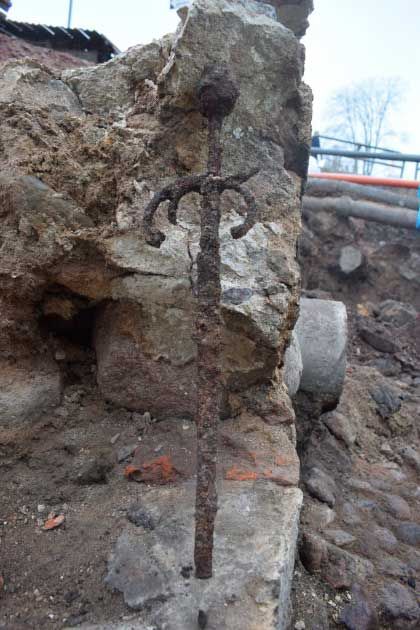In the historic city of Kalmar, located in southeastern Sweden, a team of archaeologists has made an extraordinary discovery that sheds new light on a turning point in European military history. Hidden beneath the centuries-old floor of a cellar, a well-preserved 17th-century battle-sword has been unearthed, providing a tangible connection between the era of medieval warfare and the dawn of modern military tactics. This find is not only a rare and valuable artifact but also a remarkable piece of the historical puzzle that helps us understand how warfare evolved during a time of immense political tension and technological innovation.

The excavation was conducted by Arkeologerna, a prestigious Swedish archaeological organization known for its meticulous fieldwork and contributions to historical research. The dig took place at the intersection of Kungsgatan and Västerlånggatan, a site with deep historical significance. Once the location of a medieval farmstead, this area played a key role during the Kalmar War of 1611 to 1613—a bloody conflict that marked a period of intense struggle between Sweden and Denmark-Norway over control of important trade routes and territorial claims.
As archaeologists peeled back the layers of time, they discovered more than just artifacts. They uncovered a story. Beneath the ruins of a fire-damaged structure, likely destroyed during the heat of battle, the Danish sword lay hidden for over four centuries. Its location in the debris of a building ravaged by conflict suggests it may have been lost or abandoned in the chaos of war. Its presence is a poignant reminder of the human toll of military campaigns and the destructive nature of territorial ambition.
This particular weapon stands out not only for its historical context but also for its design. Unlike earlier medieval swords, which were often heavier and less refined, this 17th-century example reflects a major shift in military technology and tactics. Its sleek, balanced construction points to the changing demands of the battlefield during what historians refer to as the “Military Revolution”—a transformative period that spanned from roughly 1560 to 1660.
During this century of upheaval, European armies underwent dramatic changes. The introduction of gunpowder, firearms, and more disciplined standing armies began to replace the old feudal levies and hand-to-hand combat strategies that had dominated for centuries. Weapons like the one discovered in Kalmar represent this evolution. They were designed not just for brute strength but for agility, precision, and adaptability in the face of new threats. The sword serves as a physical embodiment of the innovation that reshaped the very nature of warfare.
Yet the importance of this discovery extends beyond the battlefield. It offers scholars and the public a chance to reflect on how societies adapt to change—how political conflict, technological progress, and cultural shifts intersect in moments of great historical significance. The Kalmar War, often overshadowed by larger European conflicts, was a deeply consequential event for the region. The battle for control of Kalmar—a strategically located port and fortress city—was central to the broader struggle for dominance in the Baltic Sea. The war may have lasted only two years, but its effects rippled through the political and military landscapes of northern Europe for decades.
For the archaeologists involved in the project, the sword is more than an object; it is a doorway into a different world. Each detail—its craftsmanship, its materials, the location in which it was found—tells a part of the story. It allows experts to reconstruct aspects of the battle, understand how the building came to be destroyed, and speculate about the identity of the sword’s owner. Was he a Danish soldier stationed in Kalmar during the occupation? Was he a combatant who perished in the flames? These questions bring a human element to what might otherwise be viewed as an impersonal relic of war.
Moreover, the preservation of this artifact provides a rare opportunity to educate the public about the importance of historical research and the role of archaeology in piecing together our collective past. Exhibitions and museum displays that feature discoveries like this one serve to connect people with their heritage, fostering a sense of continuity and awareness of the struggles and triumphs that have shaped our present. They remind us that the past is never truly gone—it lives on in the objects we unearth, the stories we tell, and the lessons we learn.
In today’s world, where the rapid pace of technological advancement can make history feel distant or irrelevant, finds like the Kalmar battle-sword offer a crucial reminder. They show us that innovation is not a modern phenomenon, but a constant in the human experience. The people of the 17th century, like us, lived in a time of change. They adapted to new technologies, faced unpredictable threats, and navigated shifting political alliances. Their world was not so different from ours, and by studying the tools they used and the choices they made, we gain perspective on our own time.
The Kalmar discovery also reinforces the value of preserving historical sites and investing in archaeological research. As urban development continues across Europe and the globe, countless layers of history risk being lost. Responsible excavation, like the one conducted by Arkeologerna, ensures that these layers are documented and understood before they disappear. Each artifact recovered adds another chapter to the story of humanity—a story that is richer, more complex, and more inspiring than any fiction.
Ultimately, the unearthing of this 17th-century Danish sword in Kalmar is not just about weaponry or war. It’s about connection—between the past and the present, between people and their history, and between the events that shaped our world and the ways we choose to remember them. As we study and share this extraordinary find, we not only honor those who came before us, but also deepen our understanding of ourselves. The echoes of history, it turns out, are still very much alive—and they continue to speak, if only we know how to listen.





